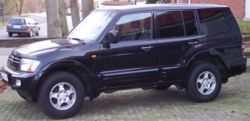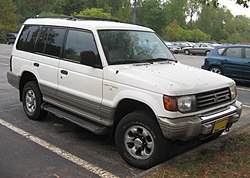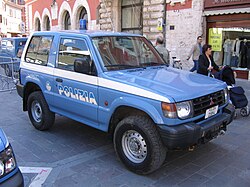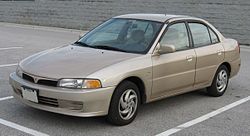First generation  |
| Production | 1982–1991 |
| Engine(s) | 3.0 L 143 hp (107 kW) V6
2.6 L 109 hp (81 kW) I4
2.0 TD I4
2.3 D I4
2.3 TD I4
2.5 TD I4 |
| Transmission(s) | 4-speed automatic
5-speed manual |
| Wheelbase | 2,695 mm (106.1 in) (LWB)
2,350 mm (92.5 in) (SWB) |
| Length | 4,650 mm (183.1 in) (LWB)
3,995 mm (157.3 in) (SWB) |
| Width | 1,680 mm (66.1 in) |
| Height | 1,890 mm (74.4 in) (LWB)
1,850 mm (72.8 in) (SWB) |
| Fuel capacity | 90 L (19.8 imp gal; 23.8 US gal) (LWB)
60 L (13.2 imp gal; 15.9 US gal) (SWB) |
| Related | Dodge Raider |
The first generation made its debut at the Tokyo Motor Show in October 1981, and was launched in May 1982. Initially, it was a three-door, short-wheelbase model available with a metal or canvas top and three different engines options:
- 2.0-litre 4-cylinder petrol (2000/2.0)
- 2.6-litre 4-cylinder petrol (Astron 2.6)
- 2.3-litre naturally aspirated diesel (2300 D)
- 2.3 liter turbocharged diesel (2300 TD/2.3 TD).
It was loaded with features that had previously not been seen on a Japanese four-wheel-drive car: a turbocharged diesel engine, a front double wishbone suspension with torsion bar springs, power steering and suspension seats. This made the Pajero a four wheel drive vehicle which integrated all the amenities of a passenger car.
In January 1983, only a year following its launch, mildly tuned production Pajeros entered the world of motor sport.
The Pajero, however, failed to appeal to everyone. It was seen to be a commercial vehicle, and since it was only available in a short wheel base form, it didn’t really appeal to those with families.
Hence, in February 1983, Mitsubishi came out with a long wheel base, five door model, to serve the needs of a larger target market. The long wheel base model was available with a choice of two different engines; a 2.0-litre turbocharged petrol (badged as "2.0 Turbo" and "2000 Turbo" in some markets) and a 2.3 liter turbocharged diesel (badged as 2.3 TD or 2300 TD).
The long wheelbase model also increased seating capacity to seven, with available third row seats, which could be folded to the sides for additional trunk space or combined with second row seats to form a bed.
The Pajero was further refined in June 1984. The turbo diesel engines now had higher power/torque ratings, whilst the long wheel base models got standard four wheel disc brakes and four way adjustable shock absorbers as standard equipment.
A new flagship model was then introduced in early 1987, with a two-tone paintjob, fifteen inch (38 cm) light alloy wheels, front seat heaters, wool seat covers, genuine leather headrests, a three spoke steering wheel and a sound system with radio/cassette. Also at this time, a version of the Pajero/Montero was marketed to Dodge dealers as the Raider, which ran through 1989.
Finally in 1988, a 3.0-litre SOHC V6 engine was made available, alongside a 2.5-litre turbo diesel engine, with the first 4x4 intercooler. This translated to better acceleration in mid to high rev ranges. The long wheel base models got a coil link suspension system for better ride comfort and off-road ability.
The first generation was introduced on May 7, 1982 and manufactured until 1991.
It was available with a 3-door body for a short wheelbase (SWB) or a 5-door body for a long wheelbase (LWB). Engines included a 2.4 L I4 with 82 kW (110 hp/112 PS), a 3.0 L V6 with EFI and 104 kW (139 hp/141 PS) and a turbocharged 2.5 L OHV diesel I4 with 62 kW (83 hp/84 PS) or an intercooled 70 kW (94 hp/95 PS). Part-time four wheel drive was standard on all models.
The Gen I platform was later built under license by Hyundai Precision Products as the Hyundai Galloper from 1991 to 2003, and exported to Europe for a brief time. While it used first generation mechanicals, the Galloper's body was closer to the second generation Pajeros.


























